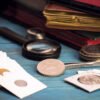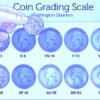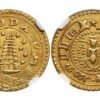Spotting Counterfeit Coins: How to Avoid Getting Fooled
As a passionate numismatist, there’s nothing quite as disheartening as realizing you’ve unknowingly added a counterfeit coin to your prized collection. With advancements in technology, counterfeiters have become increasingly skilled at creating fake coins that can be difficult to distinguish from genuine ones. However, with a keen eye and some essential knowledge, you can protect yourself from falling victim to counterfeit coins. In this article, we’ll explore valuable tips and techniques to help you spot fake coins and ensure the authenticity of your numismatic acquisitions.
Research the Genuine Coin: Before examining a coin for authenticity, familiarize yourself with the genuine version. Thoroughly research the specifications, design elements, mint marks, and any unique features of the original coin. Having this knowledge will make it easier to detect discrepancies in the counterfeit version.
Check for Weight and Dimensions: Counterfeit coins often have variations in weight and dimensions compared to authentic ones. Use a precise digital scale to measure the weight and a caliper to measure the diameter and thickness. Compare these measurements to the specifications of the genuine coin to identify any inconsistencies.
Examine the Edge: The edge of a coin can reveal vital clues about its authenticity. Genuine coins typically have uniform edges, while counterfeit coins may display uneven reeding, missing edge lettering, or casting marks.
Observe the Details: Inspect the design details on both sides of the coin closely. Counterfeit coins may have blurry or poorly defined features, especially in areas with intricate designs or fine lettering. Genuine coins boast sharp, well-defined images.
Look for Die Cracks and Errors: Genuine coins can have die cracks or minting errors that make them unique. Counterfeiters may overlook these imperfections, so familiarize yourself with known die varieties and minting errors for the coin you’re examining.
Perform the “Ping” Test: Authentic silver and gold coins produce a distinct “ping” sound when gently dropped onto a hard surface. The sound is a result of the coin’s metal composition. If the coin produces a dull thud or a different sound, it may be a counterfeit made of base metal.
Test the Magnetism: Most genuine coins are not magnetic, especially those made of precious metals. Use a magnet to see if the coin is attracted or repelled. If it exhibits strong magnetic properties, it is likely a fake.
Seek Professional Authentication: When in doubt, seek the expertise of professional numismatists or grading services. Their experience and access to advanced equipment will help verify the authenticity of a coin beyond any doubt.
Conclusion: As a collector, ensuring the authenticity of your coins is of utmost importance. By arming yourself with knowledge, practicing keen observation, and utilizing the right tools, you can spot counterfeit coins and protect your collection from fakes. Remember, the joy of numismatics lies in discovering genuine historical treasures, and with due diligence, you can continue to enjoy this captivating hobby with confidence.
Recent Posts
Social Media
Subscribe to our newsletter and enjoy a 2% discount!
Subscribe for news on new products, sales, and more!
Sign up now to receive the latest updates on promotions and coupons. Rest assured, we do not send spam!
Support
Social Media
Copyright 2024 © YGM Collections. All right reserved





